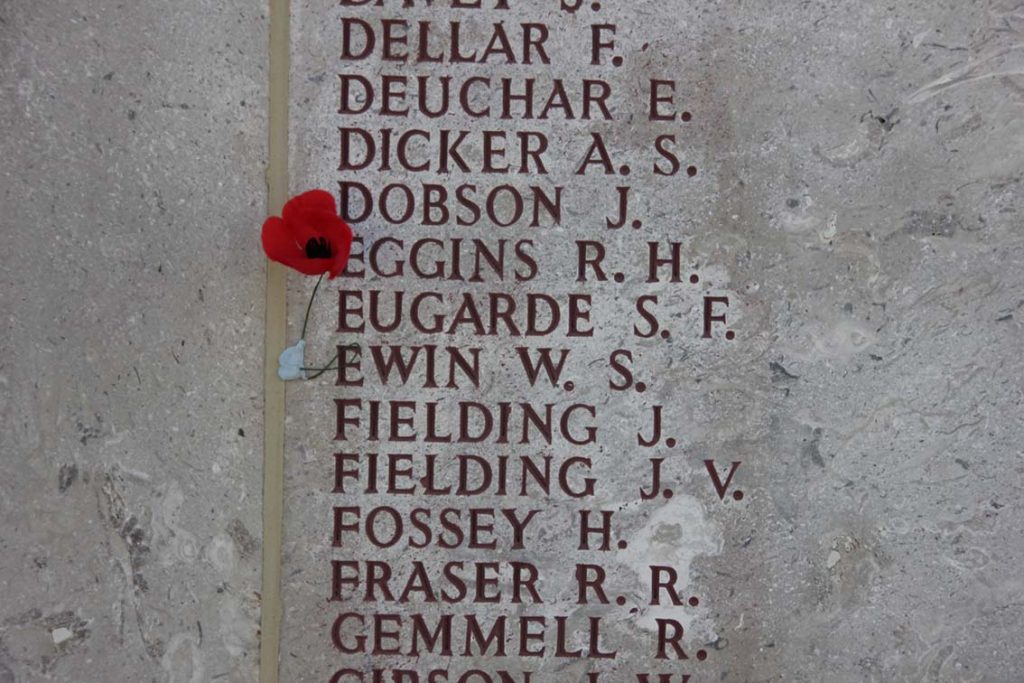Three weeks after war was declared and almost as soon as recruitment began, Walter Seccombe Ewin enlisted in Toowoomba. He became an “original” of the 9th Battalion, the first to be raised in Queensland. He trained for a short time at Enoggera from the end of August until 24 September 1914, when he sailed with the first contingent on board A5 Omrah from Brisbane. The first contingent gathered at Albany, Western Australia, then crossed the Indian Ocean, where the escorting cruiser HMAS Sydney sank the Emden in a famous engagement off the Cocos Islands.
Walter was born at Nowra in the Shoalhaven district of southern NSW, the son of William Walter and Caroline Ewin. It’s not clear when his family moved to Wyreema to farm, but Walter grew up mostly on the Downs and received his education at the Toowoomba Grammar School (1904-05). The earliest recruits for the AIF faced the most stringent physical examinations for health, height and weight. Walter was assessed by Dr Alex Horn on 31 August; he was almost 5’11” tall, weighed 164 pounds with a fair complexion, grey eyes and sandy hair. He was of the Church of England religion and was 24 years old.
In Egypt, the 9th Battalion trained near the pyramids. As part of the 1st Division, the 9th was embarked in March for the invasion of Turkey at the Dardanelles. On 25 April 1915 these first men of the AIF landed at Gallipoli, the most famous day in Australian military history. On that day the 9th Battalion, as part of the 3rd Brigade, was among the first to reach the beach. The task facing the 9th was to penetrate inland as quickly and as far as possible to seize the high ground. Following units would secure the beach. Eventually, the units would co-ordinate with the British and French in a drive towards Constantinople. The hope was that this strategy would force Turkey out of the war.
Walter Ewin was one of the men who lost his life on the first day. Several of his comrades made statements to a Court of Inquiry convened “in the field, France” in June 1916. The fact that it took over a year for the army to make a determination of his fate testifies to the confused nature of the first days of fighting at Gallipoli. Private A. Forster stated that he had seen Walter leaving the transport for the beach on the first day but by day three “noticed that he was absent.” Private A. Marshall gave a more detailed account that probably explains why Walter’s fate remained a mystery for so long. They were both members of a storming party of 30 men sent out on the day of the landing. They got a long way out, about 1.5 miles further than the front line trenches of the evacuation. At about 10 a.m. they were on Gun Ridge when they saw the Turks marching down on them in three columns. The party fell back; Ewins (sic) refused to leave the place. . . . He remained lying down and firing rapidly. He was never seen again. A drawn-out process to ascertain whether Walter had been captured was also pursued.
When the Turkish counter-attacks began on 25 April the furthest Australians were heard firing from their advanced positions. They were eventually overwhelmed where they stood. The historian Charles Bean and the Historical Mission found the remains of some of them in 1919 when they surveyed the entire battlefield. Walter remained among the missing of the first day.
At home at Wyreema, Caroline Ewin began a long correspondence with the army in search of information about her son’s fate. Some sentences from one of her letters give an insight into the painful emotional journey families endured in the Great War. On 21 November 1915 she wrote to Army Base Records,
I have been advised to apply . . . to inquire if any further news of . . . (details), . . . reported missing since June. It is so long since the above news came to us & we’ve been daily expecting to hear something further of our son. The anxiety is dreadful. If no further official news has been received, can you advise what is to be done & oblige.
Yours faithfully,
Ewin.
The Ewins would never learn more than the witness statements referred to above. Walter was almost 25 when he died; his name is inscribed on the Lone Pine Memorial.
Toowoomba Grammar School Archive Records state that he started at the school on 12th July 1904 and left on 20th April 1905. In the school magazine of November 1915 he was reported as missing. He was on the Honour Roll for the November 1916.
External Links:
National Archives of Australia Military Record
Australian Red Cross Society Wounded and Missing

Lone Pine Memorial, Gallipoli

Wreath laid by TGS Battlefield Tour 2015 at Lone Pine Memorial

Gallipoli – Positions at end of 25 April and ANZAC Artillery May 1915

Second Ridge taken from Plugges Plateau at Gallipoli by Ann Hallam

ANZAC BEACH AT 6 AM ON APRIL 25 1915 taken by Captain Harry Davies

Landing at Gallipoli 25 April 1915 courtesy of AWM

In Egypt, WS Ewin in centre – courtesy of Joanne Ewin




